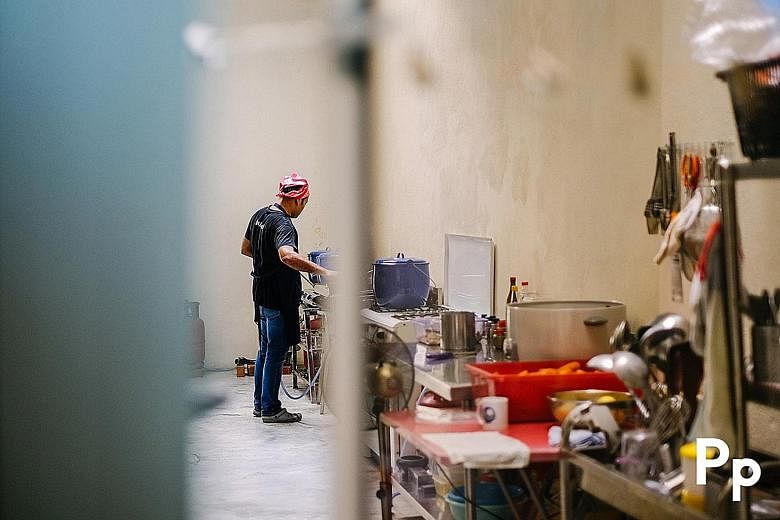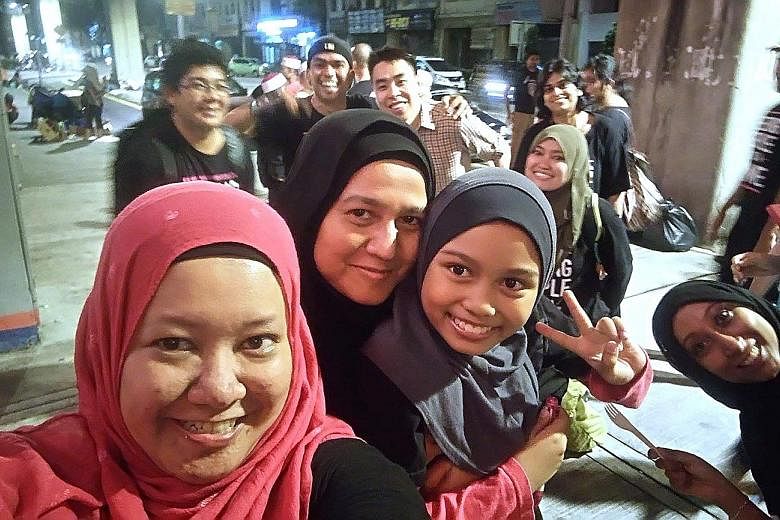Every Thursday night, volunteers with the soup kitchen Feeding the Needy turn up at a regular spot in the Chow Kit neighbourhood.
Like well-oiled machinery, the 10 volunteers set up tables to hold 550 to 600 packets of food and then begin distributing them - each a balanced meal of rice, vegetables and meat - to the homeless and urban poor waiting in an orderly queue.
It all goes like clockwork, not surprisingly so, as they have been operating there for four years.
Except for one thing. One of its co-founders, Ms Mimi Liana Nasha- ruddin, noted that in the last couple of years, a van or car would pull up nearly every week with more food packets to be given to the very same people in the queue.
These are ad hoc volunteers who turn up as and when they please, often to locations where 28 soup kitchens are operating in the inner city of Kuala Lumpur.
However, the food, shoved into the hands of people in the queue, often ends up thrown away.
-
28 NUMBER OF SOUP KITCHENS IN INNER-CITY KL
"The ad hoc volunteers don't wait until the end, so they don't see the wastage," said Ms Mimi Liana.
A bemused Ms Joycelyn Lee, co-founder of Pit Stop Community Cafe, once even had food packets shoved into her hands as she sat talking with "street friends".
"No one looks you in the eye, or asks if you want food," she said.
Ironically, even as so much food gets thrown away, established soup kitchens have to struggle with the perennial problem of funding. The problem appears to be a mix of misplaced generosity and fad.
Feeding the homeless has been going on for years as a gesture of assistance to the urban poor but in 2014, it also became a gesture of political defiance when the authorities wanted to ban soup kitchens from the city centre in a move to clean the area up.
These days, it is plain trendy to distribute food to the needy, so much so that this has created new problems such as food wastage.
Urban poverty is not a new issue in KL. Like many other major cities, KL is a magnet for people looking for a better life but not always succeeding. Some end up on the streets. Their numbers are hard to estimate but according to soup kitchens, there could be several hundred people who sleep rough in the city centre.
Their stories are diverse. Sometimes, their jobs or health fail them, and they can no longer afford housing. Some have addiction or mental health problems, are estranged from their families or are on the run from the law. Some actually have a job but do not make enough to afford housing.
The homeless tend to congregate in the older part of KL, recognisable by the large flimsy bags they lug around that hold their possessions. They rely on soup kitchens for food and essentials like toiletries. When they need a shower or to do their laundry, they head to centres that offer such amenities, or public toilets.
For decades, they have been largely invisible to those who hurry past them. But serving the homeless has now become the hottest trend in volunteerism, ironically partly because of the government's heavy-handed efforts to curb volunteerism in this area.
The Federal Territories Ministry had proposed in 2014 that soup kitchens be allowed to operate only beyond 2km of the city centre, as it wanted to spruce up the area as an important tourist zone.
The plan triggered an immediate backlash, partly because of the political mood at the time. The government was suffering from a trust deficit especially among younger Malaysians, who are also the most connected digitally.
As Tengku Aisya Tengku Saiffuddin, an 18-year-old volunteer at the Pit Stop cafe, noted, her generation is a much more politically aware and connected one. Many are pumped up and want to contribute, and they have the tools of social media to connect and organise quickly.
RISE OF AD HOC VOLUNTEERISM
On the positive side, it helped stoke a strong sense of volunteerism, and soup kitchens benefited from a rush of new volunteers.
But it also created a burst of ad hoc volunteerism, first as a gesture of political rebellion and then as a trend that persists till today.
NGO Hub director Chun Wah Hoo said the ministry's proposed move is the main cause for the surge in volunteerism for the homeless, spurred on by social media. NGO Hub is a resource platform which connects non-governmental organisations to resources like donors and volunteers.
In addition, he said, college students are required to undertake community work, and feeding the homeless is an easy activity. Unlike visiting a home for the underprivileged, for instance, it can be done on the spur of the moment. And there are no restrictions on photographs. "It is really the easiest project they can do, and it feels good with great photo opportunities," said Mr Chun.
But the consequences have not been pretty. Food wastage has shot up while city cleanliness has suffered, and excessive donations have become an unintended crutch among the urban poor. And it fails to address the real needs.
As Ms Mimi Liana noted, the urban poor do not lack food, just good food. But ad hoc volunteers often bring carbohydrate-heavy fried rice or noodles, or offload leftovers. They also do not have an end goal, which should be to try to help people get back on their feet.
Pit Stop cafe's Ms Lee said food is really just a way to reach out and offer longer-term help, which is why her cafe employs homeless people.
Pit Stop operates as a commercial eatery during lunch hours, and as a soup kitchen for dinner. It also runs skills classes, like making handicrafts and cutting hair, and has helped place and support a few homeless people in jobs.
Ms Lee said sleeping rough can quickly make people bedraggled, mistrustful and disorganised, and very few manage to hold a job for long without support.
A man who went to Pit Stop regularly eventually opened up, revealing how he ended up on the streets - he was fired from his job when he became depressed following a divorce. Pit Stop staff helped support him in a new job, and he is now back on his feet.
Another man became homeless after falling out with his family. They helped him to undergo counselling, and he later returned to Kedah to try to mend ties with his family there.
Each tiny victory is hard-won, and requires commitment.
College lecturer Siti Rahayu Baharin, who takes part in a programme called Buku Jalanan (or Street Books) for children in a working-class area, said misplaced volunteerism can be harmful.
She once asked the children about their ambition, and more than a few said they would live on the streets because it was easy and food was free. Ms Siti Rahayu said she was aghast but not surprised.
The programme's volunteers tutor 75 poor children twice a week, with the aim of connecting with them and encouraging them to strive for a better future. They also provide them with a meal. "The children often ask us about our jobs, and we try to impart to them the value and dignity of work," she said.
The NGOs have tried to harness this burst of ad hoc enthusiasm by setting up structured volunteer programmes that make it easy for time-pressed volunteers to contribute without too great a commitment.
For instance, Feeding the Needy puts out a call for volunteers every Monday for its Thursday dinner session. Pit Stop cafe, which operates from fixed premises six days a week, has slots for volunteers to do work, from cutting vegetables to distributing food to 250 people every night.
NGO Hub has produced a helpful online map of locations where the 28 soup kitchens operate and the times, in the hope that would-be volunteers would find a suitable slot for their energies.
Ad hoc volunteers are still turning up in droves but Mr Chun said the map has helped soup kitchens better explain the situation to them. He noticed that ad hoc volunteers appear more willing to listen when they see the map, which drives home the message of duplicated and wasted efforts.
On the bright side, this burst of activity has finally shone the spotlight on the issue of urban poverty.
For one thing, the government had dropped plans to ban soup kitchens in the city centre, and instead built three shelters in the area.
It remains concerned about cleanliness and other issues, but Mr Chun said the conversation has become more constructive. And public perception towards the homeless and urban poor is also changing.
The problem persists but the urban poor are now less likely to be dismissed as plain lazy, and are more likely to find assistance.
It is a small but significant step.
Correction note: Ms Mimi Liana Nasharuddin is the co-founder of Feeding the Needy, and not as stated in the original story.



